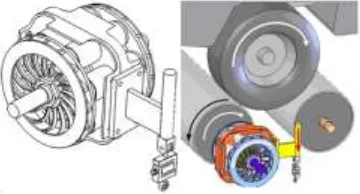2017 2nd International Conference on Software, Multimedia and Communication Engineering (SMCE 2017) ISBN: 978-1-60595-458-5
Dynamic Performance Testing System Design
for the Wheeled Vehicle Chassis
Zhi-qiang CHAO, Hao GUO, Hua-ying LI, Shou-song HAN and Xiang-bo LIU
Department of Mechanical Engineering, Academy of Armored Forces Engineering, Beijing 100072, China
Keywords: Testing system, Dynamic performance, Wheeled vehicles.
Abstract. Through the analysis of chassis dynamic performance, this paper is based on the analysis of requirements for the test of the chassis dynamic performance, combined with the dynamic performance testing technology, the design and experimental analysis of the chassis output power and the acceleration performance testing system were carried out. The result shows that this testing system can more accurately reflect the actual dynamic performance of vehicle chassis.
Introduction
Equipment and technology readiness status is the base of combat readiness, is the comprehensive embodiment of equipment reliability, repairability, and security, is an important guarantee for the Fighting Strength Forming. The implementation of technical condition detection and performance assessment of armored equipment is conducive not only to accurately grasping the basic situation of equipment, providing the basis for the deployment of combat readiness, but also conducive to the daily management work, and which is also the base of making the equipment plan of campaign, training plan and the maintenance plan ,the basic work of equipment management work, as well as the major means of keeping war equipment working well.
Along with the development of equipment technical level, also more and more highly informationized. It has always been a major problem for the army to assess the technical condition of equipment. And it’s also the difficulty for equipment using, fighting strength forming, and the management to have a good grasp of the equipment’s integrity. According to the requirement of the testing content of the technical condition of the wheel equipment, combined with the modern testing technology, signal analysis and evaluation theory, development of high reliability, usability and operability of chassis dynamic performance testing system plays an important role in improving the efficiency of maintenance and diagnosis.
Testing Principle of Dynamic Performance of Wheeled Vehicle Chassis
Vehicle dynamic performance means the performance of the vehicle during the driving: speed, maximum acceleration and maximum climbing ability. The maximum speed, acceleration ability and the maximum output power of the chassis are commonly taken as the dynamic performance evaluation criterion.
Power Testing Principle
3600 V F
Pd (1)
Where: Pd is the chassis output power (Kw); F is the force on the surface of the roller (N); V
is the linear speed of the roller surface(km/h).
Speed Testing Principle
According to the speed of the vehicle, it can provide a basis for the analysis of the acceleration performance of the vehicle, so it is of great significance for detecting the dynamic performance of vehicle chassis. When doing the vehicle speed testing, the vehicle speed can be measured according to the rotation speed of the roller in the platform, that is, according to the magnetic sensor which is arranged on the main roller, we can get the rotation speed of the roller. Then, according to the perimeter of the roller, the vehicle speed is calculated which can be expressed as:
L n
V 1.8 (2)
Where: n is the pulse frequency(Hz); L is the perimeter of the roller(m).
[image:2.595.204.392.334.428.2]Design of Chassis Dynamic Performance Testing System
Figure 1. Structure of chassis dynamic performance testing system.
Table 1. Main performance parameters of chassis dynamic performance testing system.
parameter parameter values
Allowable axle-load mass/kg 10000
Maximum absorbing power/Kw 250×3
Maximum absorbing force/N 7350×3
Maximum test speed/km/h 130
Roller diameter×length/mm 372×950
Roller inner width×outer width/mm 1300×3200
Distance from first to second axis/mm 1900±50
Distance from second to third axis/mm 1900±50
Centerline spacing of main and auxiliary rollers/mm 714
[image:2.595.135.456.469.660.2]Loading System
Loading system of the chassis dynamic performance testing system must be able to simulate all kinds of resistance of the vehicle that drives on the road, so that the resistance of the vehicle on the platform is close to the resistance when they are traveling on the road. Considering the chassis structure of the armored vehicle, performance parameters and cost factors, we choose the eddy current machine and rollers to simulate the measured vehicle loading, the structure of the eddy current dynamic performance detector is shown in figure 2.
Testing System
[image:3.595.155.433.323.431.2]The testing system of chassis dynamic performance testing system, includes two parts: force measurement and speed measurement, among which the force measuring device is mainly composed of a torsion arm, a force sensor and a signal collecting and processing device. The force measuring device is shown in figure 3, the speed measuring device mainly uses the photoelectric encoder to measure the speed of the drum, and converts it into the speed signal through the corresponding signal processor.
Figure 2. Structure of eddy current dynamic performance detector.
Figure 3. Structure of force measuring device.
Experimental Investigations
[image:3.595.206.386.476.573.2]Figure 4. Test curve of the chassis output power.
Figure 5. Test curve of the acceleration performance.
Range of the practical measured value of the chassis output power of the chassis dynamic performance testing system Fluctuate between 109kW and 133kW, the relative error is about 8% compared with the theoretical power of 120kW, within the scope of the test specification. Figure 5 shows that the chassis dynamic performance test system is mainly consistent with the road test data. The acceleration time is between 11s and 12s, and the relative error is about 1.4%, the acceleration distance is mainly kept between 52 and 57, and the relative error is about 2.23%. Errors are within the scope of the test permit. The test error is relatively small, and it has high test precision, and the test data are random sampling, the reliability is high.
Conclusion
[image:4.595.202.399.241.424.2][4] Vehicle Dynamics and Control. Rajesh Rajamani. 2012.
[5] Dynamic load and inflation pressure effects on contact pressures of a forestry forwarder tire[J]. Journal of Terramechanics. 2004 (4).


